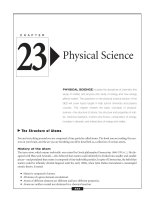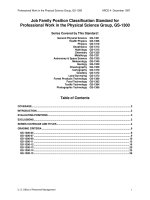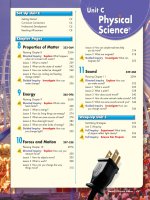4 15 objects in motion (physical science)
Bạn đang xem bản rút gọn của tài liệu. Xem và tải ngay bản đầy đủ của tài liệu tại đây (2.81 MB, 10 trang )
Physical Science
Genre
Nonfiction
Comprehension Skill
Sequence
Text Features
•
•
•
•
Captions
Labels
Call Outs
Glossary
Science Content
Motion
Scott Foresman Science 4.15
ISBN 0-328-13901-7
ì<(sk$m)=bdjabj< +^-Ä-U-Ä-U
Vocabulary
What did you learn?
force
1. How is motion measured?
frame of reference
byeffects
Kimberly
Taylor
2. What are some
that force
can have on moving
objects?
friction
gravity
kinetic energy
potential energy
Objects in Motion
3. List two types of energy. Give an example of how energy
can change from one type to another.
4.
The amount of friction between
objects depends on each object’s surface and weight.
On your own paper, write a description of the effect that
friction has on objects of different surfaces and weights.
Include details from the book to support your answer.
5.
Sequence Two dogs pull a toy with the same size
force but in opposite directions. What will happen next if
one dog pulls with more force?
relative motion
speed
velocity
work
Photographs: Every effort has been made to secure permission and provide appropriate credit for
photographic material. The publisher deeply regrets any omission and pledges to correct errors called to its
attention in subsequent editions. Unless otherwise acknowledged, all photographs are the property of Scott
Foresman, a division of Pearson Education. Photo locators denoted as follows: Top (T), Center (C), Bottom
(B), Left (L), Right (R), Background (Bkgd).
Opener: ©Alan Schein Photography/Corbis; Title Page: ©Michael S. Lewis/Corbis; 1 Getty Images; 3
©Jim Craigmyle/Corbis; 4 ©Scott T. Smith/Corbis; 5 ©Tom & Dee Ann McCarthy/Corbis; 6 ©Robin
Smith/Getty Images; 9 Jane Burton/©DK Images; 10 ©Bill Bachmann/PhotoEdit; 11 ©Stanley R.
Shoneman/Omni-Photo Communications, Inc.; 12 (BL) ©World Perspectives/Getty Images, (TR) ©DK
Images; 13 ©DK Images; 14 (BL) ©John Lund/Getty Images, (BR) ©Michael S. Lewis/Corbis; 15
©Royalty-Free/Corbis
ISBN: 0-328-13901-7
Copyright © Pearson Education, Inc.
All Rights Reserved. Printed in the United States of America. This publication is
protected by Copyright and permission should be obtained from the publisher prior
to any prohibited reproduction, storage in a retrieval system, or transmission in any
form by any means, electronic, mechanical, photocopying, recording, or likewise. For
information regarding permissions, write to: Permissions Department, Scott Foresman,
1900 East Lake Avenue, Glenview, Illinois 60025.
3 4 5 6 7 8 9 10 V010 13 12 11 10 09 08 07 06 05
What is motion?
Types of Motion
An object can move in a straight line. A train on a track
often travels in a straight line. A baseball player usually runs
from base to base in a straight line.
An object can also move in a curved path. A car moves in a
curved path when it turns a corner. Curved motion takes place
around a center point. A bicycle wheel moves
in a curved path around its axle.
An object can also move back
and forth. Plucking a guitar string
makes it move back and forth. This
motion is called a vibration.
When you walk down the street, you pass objects that do
not move. You know you are moving when you pass a fixed
object. If you stand still, you know that a car is moving because
its position changes. You can
compare how objects seem to
change their positions. The
change in an object’s position
compared to another object’s
position is relative motion.
From your position on the sidewalk,
you see the bus change position as
it moves toward you.
The toy cars move in different
paths around the track.
2
3
How You Know You Are Moving
How do you know if someone on a water slide is moving?
How do you know if the water moves? You can see how the
positions of the water and the person change. You see their
positions changing compared to the slide.
Your frame of reference is made up of the objects you use
to notice movement. It is your point of view. How an object
seems to move depends on your frame of reference.
Suppose you are riding on a float in a parade. The float
moves past people watching the parade, and you wave at
them. From your frame of reference, the people seem to be
moving. But the people haven’t moved! As the parade moves,
people on the sidewalk see you pass by. From their frame of
reference, you are moving.
Suppose you are sitting at your desk in school. You would
say you are not moving. If you use the Sun as your frame of
reference, however, you would say that you, your desk, and
your school are all moving. This is because you travel with
Earth as it moves around the Sun.
From your frame of reference on the bus, everything
on the bus seems to be staying in the same place, and
everything outside the bus seems to be moving.
4
5
Measuring Motion
Speed is the rate at which an object changes position.
It tells how fast an object moves. Speed is measured in units of
distance divided by units of time. One way to measure speed
is in kilometers per hour. If one car is moving at a high speed
and one is moving at a low speed, which one changes position
faster? The car moving at a high speed does. You can find the
average speed of an object. To do this, you divide the distance
the object moves by the time it takes.
6
Velocity is both the speed and the direction an object is
moving. Direction can be given by words such as east, west,
south, and north. Other words that tell direction are down, up,
left, and right.
An acceleration is any change in an object’s speed or
direction. Speeding up is an acceleration. Slowing down is
also an acceleration. The speed of a roller coaster on a curved
path does not have to change in order for it to accelerate. It
accelerates because it changes direction as it travels on the
curved path.
7
How does force affect
moving objects?
Force
A force is a push or pull. Force can make a fixed object
move. It can also make a moving object stop, change direction,
slow down, or move faster.
Sometimes a force must touch an object to have an effect on
it. This is a contact force. You must hit a marble with an object,
such as your finger, in order to make it move on a level surface.
Some forces can act on an object without touching it.
A magnet can pull a piece of iron toward it without touching
the iron.
Pushing or pulling can change an object’s position and
motion. A strong magnet can pull a piece of iron toward it from
farther away than a weak magnet can. The change that takes
place depends on how strong the force is.
Combining Forces
Forces have size and direction. These dogs are combining
forces. But they are working against each other. They are
pulling the toy in opposite directions, but they are pulling with
the same size force. The forces are balanced. The toy does not
move. If one dog pulls with more force, the forces will not be
balanced. The toy will move toward the dog that is using
more force.
Sometimes more than one force acts on objects. If you and
your friend push on opposite sides of a door with the same size
force, the forces are balanced. The door will not move. If you
push one side of the door while your friend pulls the other side,
the forces are acting in the same direction. The door will move
toward your friend. The total force on an object is found by
adding all of the forces.
A moving marble
hits one that is
standing still. The
contact force of
the moving marble
makes the other
marble move.
8
9
Force and Motion
Friction
Two or more forces acting on an object in opposite directions
can be balanced. The object does not move. A still object starts
to move only when the forces acting on it change. Inertia is the
resistance an object has to any change in motion.
A moving object also changes its motion only when a force
acts on it. A moving object will keep moving at the same speed
and in the same direction as long as balanced forces are acting
on it. An object can change speed or direction if the force acting
on it changes.
More force is needed to change the motion of an object with
more mass. You can easily pull an empty wagon. When you
put objects in the wagon, you add mass. You must pull with
more force to move the wagon.
Friction is a force that acts
when two surfaces rub together.
Friction can keep objects from
moving. It can slow or stop
moving objects. Friction depends
on an object’s surface and
weight.
Rubbing together objects
with rough surfaces causes a
lot of friction. Rubbing together
objects with smooth surfaces
causes less friction.
A box of feathers is easy to
This Super Slide has a very
push. The same box filled with
smooth surface.
books presses against the floor
with more force. The box is harder to move.
You can reduce friction between objects. Wax or oil can make
surfaces smoother. You need less force to move objects with less
friction between them.
These horses are using
force to move the plow.
10
11
How are force, mass,
and energy related?
The Force of Gravity
A ball falls to the ground when you drop it. The
force that acts on the ball to make it fall is called
gravity. Gravity is a force that makes objects pull
toward each other. The amount of force between
two objects depends on the distance between them
and their masses.
If objects are close together, the force of gravity
is strong. Gravity is weaker when the objects are
farther apart. As the mass of the objects is reduced,
the force of gravity between them is also reduced.
If the mass of one object doubles, the force of
gravity between it and another object doubles.
Earth’s mass pulls on a ball, causing it to fall.
The ball also pulls on Earth. But the ball does not
have enough mass to move Earth.
Measuring Force
You can measure force with a spring
scale. A spring scale has a hook on the
bottom. When you hang an object from
the hook, the spring inside stretches.
The object’s weight determines how
much the spring stretches. Weight is a
measure of the force of gravity that acts
on an object’s mass. A heavy object has
a strong force. A strong force will make
the spring stretch more.
A marker on the scale moves along
a number line as the spring stretches.
The numbers on the scale show a unit
of force called the newton. The newton
was named after Sir Isaac Newton, who
explained how motion and force are
related. It takes about one newton of
force to lift a small apple.
Spring
scale
The Moon has less mass than
Earth. The force of gravity is
not as strong on the Moon.
12
13
Energy and Motion
Changing Kinds of Energy
Energy is the ability to do work. Work is the ability to move
something. Work causes a change. Any change in motion
requires energy.
Kinetic energy is the energy of motion. All moving things
have kinetic energy. The faster an object moves, the more
kinetic energy it has. The amount of kinetic energy depends on
an object’s mass and speed.
Wind the spring of a toy bird. Each turn winds the spring
inside the toy tighter. This adds more stored, or potential,
energy. When you release the toy, the bird hops forward as the
spring unwinds. The energy stored in the spring changes into
kinetic energy.
You can change a rock’s potential energy into kinetic energy
by pushing it so that it starts to roll down a hill. The total
amount of energy always stays the same. Energy cannot be
made or destroyed.
Stored Energy
The swing in the picture stops briefly
when it reaches the top of its path. The
stopped swing has potential energy,
or energy that is stored. Potential energy
changes into kinetic energy once
the swing begins to move again.
An object that has been
stretched or squeezed
has potential energy.
A wind up toy has
potential energy in
its tightened spring.
A wrecking
ball has a lot of
kinetic energy
before it crashes
into a building.
14
15
Vocabulary
Glossary
What did you learn?
force
force
any push or pull
1. How is motion measured?
frame
reference
frame ofofreference
the point of view from which you
detect motion
2. What are some effects that force can have on moving
objects?
friction
friction
gravity
gravity
kinetic energy
the force that acts when two surfaces
rub together
the force that makes objects pull
toward each other
potential
energy
kinetic energy
the energy of motion
relative
motion
potential
energy
stored kinetic energy
relative motion
speed
velocity
the rate at which an object changes
position
velocity
the speed and the direction in which
an object is moving
work
the ability to move something or
Photographs: Every effort has been made to secure permission and provide appropriate credit for
make
change
photographic material. The publisher deeply
regretsaany
omission and pledges to correct errors called to its
attention in subsequent editions. Unless otherwise acknowledged, all photographs are the property of Scott
Foresman, a division of Pearson Education. Photo locators denoted as follows: Top (T), Center (C), Bottom
(B), Left (L), Right (R), Background (Bkgd).
Opener: ©Alan Schein Photography/Corbis; Title Page: ©Michael S. Lewis/Corbis; 1 Getty Images; 3
©Jim Craigmyle/Corbis; 4 ©Scott T. Smith/Corbis; 5 ©Tom & Dee Ann McCarthy/Corbis; 6 ©Robin
Smith/Getty Images; 9 Jane Burton/©DK Images; 10 ©Bill Bachmann/PhotoEdit; 11 ©Stanley R.
Shoneman/Omni-Photo Communications, Inc.; 12 (BL) ©World Perspectives/Getty Images, (TR) ©DK
Images; 13 ©DK Images; 14 (BL) ©John Lund/Getty Images, (BR) ©Michael S. Lewis/Corbis; 15
©Royalty-Free/Corbis
ISBN: 0-328-13901-7
Copyright © Pearson Education, Inc.
All Rights Reserved. Printed in the United States of America. This publication is
protected by Copyright and permission should be obtained from the publisher prior
to any prohibited reproduction, storage in a retrieval system, or transmission in any
form by any means, electronic, mechanical, photocopying, recording, or likewise. For
information regarding permissions, write to: Permissions Department, Scott Foresman,
1900 East Lake Avenue, Glenview, Illinois 60025.
3 4 5 6 7 8 9 10 V010 13 12 11 10 09 08 07 06 05
16
4.
The amount of friction between
objects depends on each object’s surface and weight.
On your own paper, write a description of the effect that
friction has on objects of different surfaces and weights.
Include details from the book to support your answer.
5.
Sequence Two dogs pull a toy with the same size
force but in opposite directions. What will happen next if
one dog pulls with more force?
the change in one object’s position
compared to another object’s position
speed
work
3. List two types of energy. Give an example of how energy
can change from one type to another.









